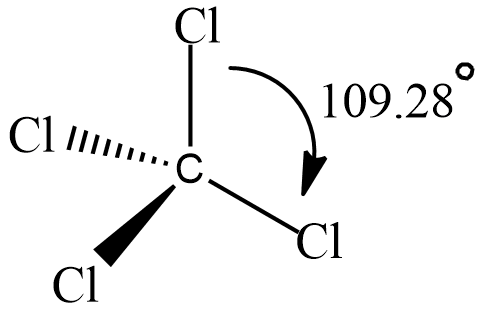
Name the compound with bond angles that are exactly
Answer
417k+ views
1 likes
Hint: To answer this question we should have a basic idea about Bond angles. Bond angle can be defined as the angle made by two covalent bonds, these two covalent bonds are produced by the same atom. We will discuss more about the bond angle in this question to understand it better for identifying the required compound.
Complete answer:
Bond angle is a Bond property or bond parameter that provides information about the molecular geometry of the compound. Bond angle depends upon several factors which are
Number of lone pairs: If there are more lone pairs in the compound then there will be lone pair-bond pair repulsion and bond angle is reduced.
Size of central atom and surrounding atoms: If the size of atoms is larger than the electrons have more space to occupy and they face less repulsion from other electrons and gap between bond pairs increases resulting in increasing the bond angle.
Electronegativity of central atoms of surrounding atoms: If atoms are more electronegative than the electrons will be attracted more towards them resulting in decreasing the bond angle.
A compound named Carbon tetrachloride has bond angles that are exactly

It has tetrahedral geometry and each
Note:
The bond angle provides us a rough idea on location of lone pairs as well as bond pairs, it also tells us about the location of the central atom and surrounding atoms in the compound so that we can determine the shape and geometry of the compound.
Complete answer:
Bond angle is a Bond property or bond parameter that provides information about the molecular geometry of the compound. Bond angle depends upon several factors which are
Number of lone pairs: If there are more lone pairs in the compound then there will be lone pair-bond pair repulsion and bond angle is reduced.
Size of central atom and surrounding atoms: If the size of atoms is larger than the electrons have more space to occupy and they face less repulsion from other electrons and gap between bond pairs increases resulting in increasing the bond angle.
Electronegativity of central atoms of surrounding atoms: If atoms are more electronegative than the electrons will be attracted more towards them resulting in decreasing the bond angle.
A compound named Carbon tetrachloride has bond angles that are exactly

It has tetrahedral geometry and each
Note:
The bond angle provides us a rough idea on location of lone pairs as well as bond pairs, it also tells us about the location of the central atom and surrounding atoms in the compound so that we can determine the shape and geometry of the compound.
Latest Vedantu courses for you
Grade 10 | CBSE | SCHOOL | English
Vedantu 10 CBSE Pro Course - (2025-26)
School Full course for CBSE students
₹37,300 per year
Recently Updated Pages
Master Class 11 Economics: Engaging Questions & Answers for Success

Master Class 11 Business Studies: Engaging Questions & Answers for Success

Master Class 11 Accountancy: Engaging Questions & Answers for Success

Master Class 11 English: Engaging Questions & Answers for Success

Master Class 11 Computer Science: Engaging Questions & Answers for Success

Master Class 11 Maths: Engaging Questions & Answers for Success

Trending doubts
State and prove Bernoullis theorem class 11 physics CBSE

1 ton equals to A 100 kg B 1000 kg C 10 kg D 10000 class 11 physics CBSE

State the laws of reflection of light

One Metric ton is equal to kg A 10000 B 1000 C 100 class 11 physics CBSE

1 Quintal is equal to a 110 kg b 10 kg c 100kg d 1000 class 11 physics CBSE

Difference Between Prokaryotic Cells and Eukaryotic Cells




